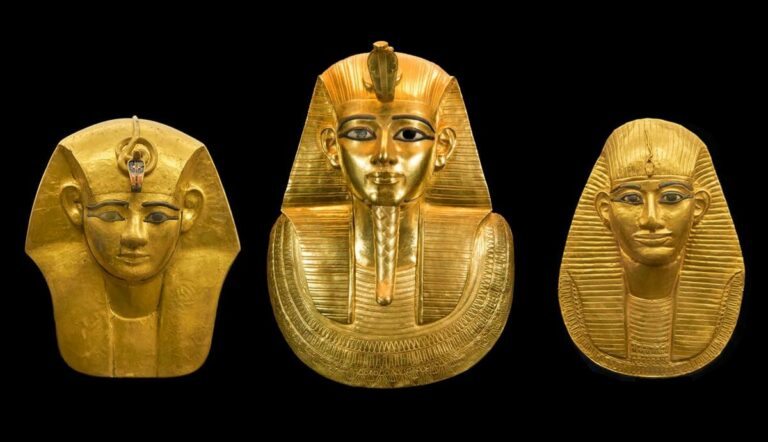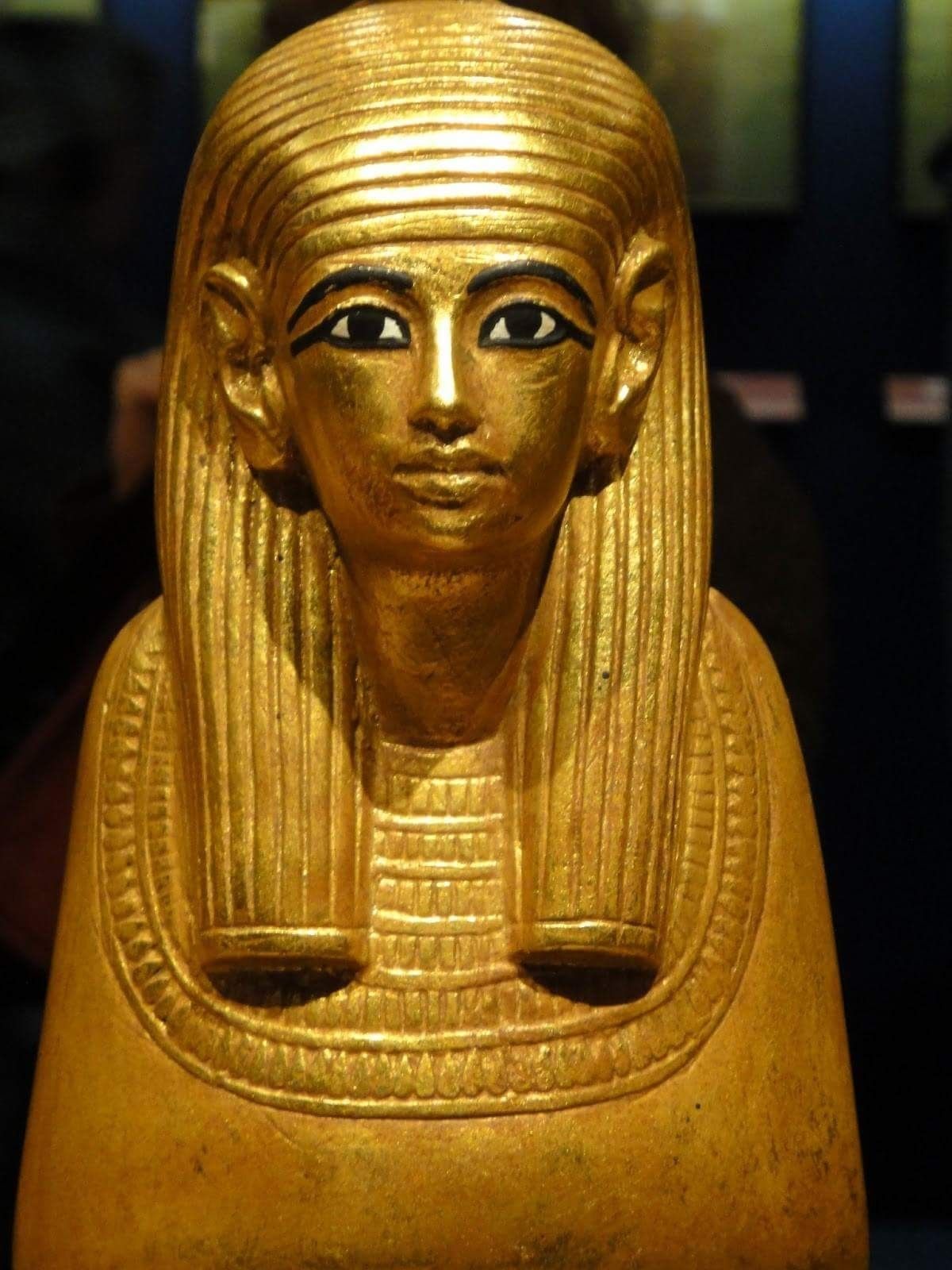Meaning
Amenhotep is an ancient Egyptian name composed of two parts: “Amen” and “hotep.”
• “Amen” is a powerful Egyptian god, often associated with creation, fertility, and the air.
• “Hotep” means “contentment” or “satisfaction.”
Therefore, the name Amenhotep can be interpreted as meaning “Contentment of Amen” or “He who is contented by Amen.”
This suggests a sense of peace and satisfaction found through devotion to the god Amen.
Amenhotep was a popular royal name in ancient Egypt, borne by several pharaohs throughout history. Notably, Akhenaten, formerly known as Amenhotep IV, is perhaps the most famous Amenhotep in history.
He is known for his radical religious reforms, shifting the focus of worship from the traditional polytheistic system to the sole god Aten, a sun disc deity.
Amenhotep is a name of ancient Egyptian origin, composed of two parts: “Amun” and “hotep.”
“Amun” refers to Amun-Ra, the chief god in the ancient Egyptian pantheon, often depicted as a ram-headed deity associated with creation, fertility, and kingship.
“Hotep” translates to “he who is pleased,” or “the one who brings joy,” signifying satisfaction, contentment, and well-being.
Therefore, Amenhotep literally means “Amun is satisfied” or “The one who brings joy to Amun.”
This name was borne by several prominent pharaohs of the Eighteenth Dynasty, most notably Amenhotep III, a powerful ruler known for his lavish constructions and prosperity, and Amenhotep IV, later known as Akhenaten, who initiated a radical religious revolution by promoting Aten, the sun disk, as the sole deity.
The name Amenhotep embodies both power and devotion to Amun, reflecting the deeply ingrained religious beliefs of ancient Egyptian society.
It highlights the importance placed on pleasing the gods and attaining their favor for the well-being of the kingdom.
Associated concepts with the name include:
Royalty: Many pharaohs bore the name Amenhotep, signifying a connection to divine power and legitimacy.
Religion: The name is intrinsically linked to Amun, illustrating the central role of religion in ancient Egyptian life.
Power: The association with Amun suggests strength, dominion, and influence.
Stability: “Hotep” implies peace, contentment, and prosperity, reflecting a desire for societal harmony.
Origin and History
Amenhotep is a common Egyptian name that appears throughout history, spanning different dynasties. Its meaning, reflecting the religious beliefs of ancient Egyptians, is significant in understanding its cultural context.
The name *Amenhotep* is composed of two parts: *amen* and *hoteph*.
*Amen*, a central deity in Egyptian religion, represented creation, air, and cosmic order.
*Hotep* means “he who comes” or “one who is satisfied,” often associated with happiness and well-being.
Therefore, the full name *Amenhotep* can be interpreted as “***Amen*** is *satisfied*” or “**He Who Is Satisfied by Amen***.” This suggests a strong connection to the divine favor of **_the creator deity_**, emphasizing a sense of contentment and blessedness bestowed upon individuals bearing this name.
The popularity of this name highlights its significance in ancient Egyptian society. It was borne by numerous pharaohs, including notable rulers such as **Amenhotep I,** **Amenhotep III,** and the infamous **Akhenaten** (originally Amenhotep IV).
Each pharaoh who carried the name *Amenhotep* navigated a specific historical context, leaving behind their own legacy. However, the shared element of their names underscores the enduring power and influence of religious beliefs in shaping not only individual identities but also the very fabric of Egyptian civilization.
Amenhotep is a prominent ancient Egyptian name with a rich historical and linguistic background.
It originates from a compound word formed from two elements: “Amen,” meaning “hidden” or “invisible” and “hop” signifying “he who is born.”
Therefore, Amenhotep translates to “the hidden one has been born” or “the invisible one was born.”
This name likely carried profound theological significance in ancient Egypt. The god _Amen_, considered the supreme deity, represented creation and cosmic order.
Associating a pharaoh with this divine entity strengthened the ruler’s legitimacy and connection to the celestial realm.
Over centuries, variations of the name emerged as the spelling and pronunciation evolved. Some notable variations include:
- Amenhotep I:
- Amenhotep II:
- Amenhotep III:
- Akhenaten (formerly Amenhotep IV):
- Tutankhamun (originally Tutankhaten, meaning “living image of Aten”):
These variations highlight the dynastic nature of the name and its enduring presence throughout ancient Egyptian history. The name Amenhotep is a testament to the profound religious beliefs and cultural heritage of this ancient civilization.
Notable Amenhotep Figures
Amenhotep was a common name during the Eighteenth Dynasty of ancient Egypt, meaning “Amon is pleased.” It was bestowed upon pharaohs, princes, and commoners alike.
Several notable figures bore the name Amenhotep, making it difficult to pinpoint which individual is being referenced without context.
However, perhaps the most famous Amenhotep is Akhenaten, originally named Amenhotep IV. He reigned during the 18th Dynasty (c. 1353–1336 BCE) and is known for his radical religious revolution.
Akhenaten abandoned traditional polytheism in favor of a monotheistic belief system centered on Aten, the sun disk. He moved the capital to Amarna and changed his name to reflect this new deity.
His reign was marked by artistic innovation, evidenced by the distinctive elongated features and unnatural poses found in Amarna art.
Akhenaten’s religious reforms were controversial and ultimately unsuccessful. After his death, his successors reverted to traditional polytheism and largely erased his legacy.
Another significant Amenhotep was Amenhotep III (reigned c. 1390–1353 BCE), a prosperous pharaoh known for his building projects and international relations.
His reign is considered one of the golden ages of Egypt, marked by peace and prosperity.
Other notable Amenhotep figures include:
• Amenhotep I (reigned c. 1525–1504 BCE), a successful pharaoh who strengthened Egypt’s power after a period of instability.
• Amenhotep II (reigned c. 1427–1401 BCE), known for his military campaigns and building projects.
•Amenhotep IV (Akhenaten)
The enduring popularity of the name Amenhotep highlights its significance in ancient Egyptian culture. It represents a connection to Amon, the patron deity of Thebes, and signifies favor from the gods.
Amenhotep, a name meaning “Amun is satisfied,” holds significant historical weight within ancient Egypt, particularly during the Eighteenth Dynasty (circa 1550-1292 BCE).
Several prominent figures bore this name, each leaving an indelible mark on Egyptian history and culture. Here are some notable Amenhotep figures:
- Amenhotep I (reigned c. 1525-1504 BCE): A successful pharaoh known for expanding Egypt’s borders, strengthening its military, and initiating trade with other nations.
- Amenhotep II (reigned c. 1427-1398 BCE): A powerful ruler who continued his father’s expansionist policies, engaging in extensive military campaigns in Nubia and Syria.
- Amenhotep III (reigned c. 1390-1352 BCE): Known for his prosperous reign characterized by economic growth, artistic flourishing, and monumental building projects like the Temple of Luxor.
- Akhenaten (formerly Amenhotep IV; reigned c. 1353-1336 BCE): A controversial pharaoh who ushered in a revolutionary period marked by religious upheaval. He attempted to establish monotheism, worshiping the sun god Aten and discarding traditional deities. His reforms were short-lived but had a profound impact on Egyptian history.
- Tutankhamun (Amenhotep V; reigned c. 1332-1323 BCE): A young pharaoh who restored the traditional polytheistic religion after Akhenaten’s reign. His tomb, remarkably intact, has provided invaluable insights into Egyptian burial practices and artistry.
- Amenhotep IV (reigned c. 1362-1350 BCE): A ruler who ruled briefly during the waning years of Amenhotep III’s reign. While little is known about his life, his name suggests a connection to the cult of Amun.
- Amenhotep VI (reigned c. 1350-1336 BCE): Another short-lived ruler who succeeded Akhenaten and attempted to restore traditional religion. His reign saw a gradual return to normalcy after the upheaval of the Amarna Period.
Beyond these prominent pharaohs, numerous other individuals named Amenhotep held positions of influence during various periods of Egyptian history.
Their roles spanned diverse sectors, including priesthood, administration, and military leadership. While their individual stories may be less well-documented, their presence in historical records underscores the enduring significance of the name Amenhotep in ancient Egypt.
- Meaning, Origin And History Of The Name Ginka - April 27, 2025
- Best Leadzai Alternatives for 2025 - April 25, 2025
- Best GetProspect Alternatives for 2025 - April 25, 2025


